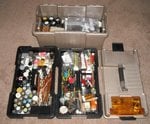- Thread starter
- #21
I have checked the vids, still busy cleaning the sprues. And trying to decide what paint to buy.
I want to but revell waterpaints, I think these are easier to work with compared to oil based paints (correct?)
Is there a color chart on how to convert ( for excample) Revel 15 -> waterbased color?
Or an RLM color to the waterbased paint?
I want to but revell waterpaints, I think these are easier to work with compared to oil based paints (correct?)
Is there a color chart on how to convert ( for excample) Revel 15 -> waterbased color?
Or an RLM color to the waterbased paint?
Last edited:


